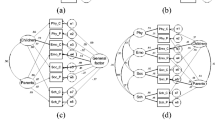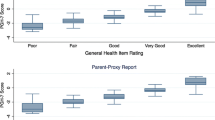Abstract
An important assumption for comparing children’s quality of life (QoL) between children’s and parents’ perceptions is that measurement equivalence/invariance (ME/I) exists. The ME/I across the child- and parent-reported Chinese PedsQL was examined, and the latent means between child self-reports and parent-proxy reports were compared. Third-grade to sixth-grade children (n = 519) and their parents (n = 270) respectively completed the child- and parent-reported PedsQL. Seventy-eight parents completed parent-proxy reports twice. Full ME/I across child and parent reports was found in first- and second-order factor loadings. Partial ME/I was supported in item intercepts and item residual variances. The latent means of child self-reports and of parent-proxy reports were not significantly different, which suggested interchangeability between child- and parent-reported PedsQL. The ME/I results support the use of PedsQL scores to compare children’s and parents’ perceptions of children’s QoL.
Similar content being viewed by others
References
Basu D (2004) Quality-of-life issues in mental health care: past, present, and future. German J Psychiatry 7:35–43
Salek S (1998) Compendium of quality of life instruments. Wiley, Chichester
Ravens-Sieberer U, Erhart M, Wille N, Wetzel R, Nickel J, Bullinger M (2006) Generic health-related quality-of-life assessment in children and adolescents: methodological considerations. Pharmacoeconomics 24:1199–1220
Varni JW, Burwinkle TM, Seid M, Skarr D (2003) The PedsQL 4.0 as a pediatric population health measure: feasibility, reliability, and validity. Ambulatory Pediatr 3:329–341
Varni JW, Seid M, Knight TS, Uzark K, Szer IS (2002) The PedsQL 4.0 generic core scales: sensitivity, responsiveness, and impact on clinical decision-making. J Behav Med 25:175–193
Varni JW, Seid M, Kurtin PS (2001) PedsQL 4.0: reliability and validity of the pediatric quality of life inventory version 4.0 generic core scales in healthy and patient populations. Med Care 39:800–812
Varni JW, Seid M, Rode CA (1999) The PedsQL: measurement model for the pediatric quality of life inventory. Med Care 37:126–139
Ravens-Sieberer U, Bullinger M (1998) Assessing health-related quality of life in chronically ill children with the German KINDL: first psychometric and content analytical results. Qual Life Res 7:399–407
Ravens-Sieberer U, Bullinger M (2000) KINDLR questionnaire for measuring health-related quality of life in children and adolescents: revised version manual. [Accessed 26 June 2012]. Retrieved from http://kindl.org/cms/wp-content/uploads/2009/11/ManEnglish.pdf
Hughes AR, Farewell K, Harris D, Reilly JJ (2007) Quality of life in a clinical sample of obese children. Int J Obes 31:39–44
Ingerski LM, Janicke DM, Silverstein JH (2007) Brief report: quality of life in overweight youth-the role of multiple informants and perceived social support. J Pediatr Psychol 32:869–874
Pinhas-Hamiel O, Singer S, Pilpel N, Fradkin A, Modan D, Reichman B (2006) Health-related quality of life among children and adolescents: associations with obesity. Int J Obes 30:267–272
Zeller MH, Modi AC (2006) Predictors of health-related quality of life in obese youth. Obesity 14:122–130
Eiser C, Morse R (2001) Can parents rate their child’s health-related quality of life? Results of a systematic review. Qual Life Res 10:347–357
Upton P, Lawford J, Eiser C (2008) Parent-child agreement across child health-related quality of life instruments: a review of the literature. Qual Life Res 17:895–913
Klassen AF, Miller A, Fine S (2006) Agreement between parent and child report of quality of life in children with attention-deficit/hyperactivity disorder. Child Care Health Dev 32:397–406
White-Koning M, Arnaud C, Dickinson HO, Thyen U, Beckung E, Fauconnier J et al (2007) Determinants of child-parent agreement in quality-of-life reports: a European study of children with cerebral palsy. Pediatrics 120:e804–e814
Matziou V, Perdikaris P, Feloni D, Moshovi M, Tsoumakas K, Merkouris A et al (2008) Cancer in childhood: children’s and parents’ aspects for quality of life. Eur J Oncol Nurs 12:209–216
Robitail S, Simeoni MC, Ravens-Seiberer U, Bruil J, Auquier P (2007) Children proxies’ quality-of-life agreement depended on the country using the European KIDSCREEN-52 questionnaire. J Clin Epidemiol 60:469–478
Jozefiak T, Larsson B, Wichstrom L, Mattejat F, Ravens-Seiberer U (2008) Quality of life as reported by school children and their parents: a cross-sectional survey. Health Qual Life Outcomes 6:34
Cremeens J, Eiser C, Blades M (2006) Factors influencing agreement between child self-report and parent proxy-reports on the pediatric quality of life inventory 4.0 (PedsQL) generic core scales. Health Qual Life Outcomes 4:58
Limbers CA, Newman DA, Varni JW (2008) Factorial invariance of child self-report across age subgroups: a confirmatory factor analysis of ages 5 to 16 years utilizing the PedsQL 4.0 Generic Core Scales. Value Health 11:659–668
Lin C-Y, Luh W-M, Yang A-L, Su C-T, Wang J-D, Ma H-I (2012) Psychometric properties and gender invariance of the Chinese version of the self-report pediatric quality of life inventory version 4.0: short form is acceptable. Qual Life Res 21:177–182
Chan KS, Mangione-Smith R, Burwinkle TM, Rosen M, Varni JW (2005) The PedsQL: reliability and validity of the short-form generic core scales and Asthma Module. Med Care 43:256–265
Enders CK (2006) Analyzing structural equation models with missing data. In: Hancock GR, Mueller RO (eds) Structural educational modeling: a second course. Information Age Publishing, Greenwich, pp 315–344
Raykov T (1997) Estimation of composite reliability for cogeneric measures. Appl Psychol Meas 22:173–184
Raykov T, Shrout PE (2002) Reliability of scales with general structure: point and interval estimation using covariance structure modeling. Struct Equal Model 9:159–212
Rosner B (2006) Fundamentals of biostatistics, 6th edn. Thomson Brooks/Cole, Belmont, pp 613–617
Hoyle RH, Panter AT (1995) Writing about structural equation modeling. In: Hoyle RH (ed) Structural equation modeling: concepts, issues, and application. Sage Publications, Thousand Oaks
Ullman JB (2007) Structural equation modeling. In: Tabachnick BG, Fidell LS (eds) Using multivariate statistics. Pearson Education Inc, Boston, pp 676–780
Marsh HW, Hau K-T, Wen Z (2004) In search of golden rules: comment on hypothesis-testing approaches to setting cutoff values for fit indexes and dangers in overgeneralizing Hu and Bentler’s (1999) findings. Struct Equal Model 11:320–341
Vandenberg RJ, Lance CE (2000) A review and synthesis of the measurement invariance literature: suggestions, practices, and recommendations for organizational research. Organ Res Methods 3:4–70
Byrne BM, Schavelson RJ, Muthen B (1989) Testing for the equivalence of factor covariance and mean structures: the issue of partial measurement invariance. Psychol Bull 105:456–466
Steenkamp JEM, Baumgartner H (1998) Assessing measurement invariance in cross-national consumer research. J Consum Res 25:78–90
Jöreskog KG (2002) Censored variables and censored regression. [Accessed 26 June 2012]. Retrieved from http://www.ssicentral.com/lisrel/techdocs/censor.pdf
Kline RB (1998) Principles and practice of structural equation modeling. Guilford Press, New York
Chen FF, Sousa KH, West SG (2005) Testing measurement invariance of second-order factor models. Struct Equal Model 12:471–492
Chen FF (2007) Sensitivity of goodness of fit indexes to lack of measurement invariance. Struct Equal Model 14:464–504
Lin C-Y, Su C-T, Ma H-I (2012) Physical activity patterns and quality of life of overweight boys: a preliminary study. Hong Kong J Occup Ther 22:31–37
Petersen S, Hagglof B, Stenlund H, Bergstrom E (2009) Psychometric properties of the Swedish PedsQL, pediatric quality of life inventory 4.0 generic core scales. Acta Paediatr 98:1504–1512
Varni JW (2007) Available translations of the PedsQL™ Scales and Modules. Mapi Research Institute, Lyon
Hsieh P-L, FitzGerald M (2005) Childhood obesity in Taiwan: review of the Taiwanese literature. Nurs Health Sci 7:134–142
Cheung GW, Rensvold RB (1999) Testing factorial invariance across groups: a reconceptualization and proposed new method. J Manage 25:1–27
Author information
Authors and Affiliations
Corresponding author
Rights and permissions
About this article
Cite this article
Lin, CY., Luh, WM., Cheng, CP. et al. Measurement Equivalence across Child Self-Reports and Parent-Proxy Reports in the Chinese Version of the Pediatric Quality of Life Inventory Version 4.0. Child Psychiatry Hum Dev 44, 583–590 (2013). https://doi.org/10.1007/s10578-012-0352-8
Published:
Issue Date:
DOI: https://doi.org/10.1007/s10578-012-0352-8




